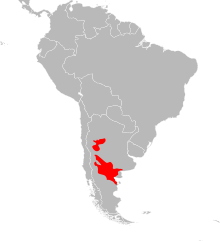| Liolaemus darwinii | |
|---|---|
| Scientific classification | |
| Domain: | Eukaryota |
| Kingdom: | Animalia |
| Phylum: | Chordata |
| Class: | Reptilia |
| Order: | Squamata |
| Suborder: | Iguania |
| Family: | Liolaemidae |
| Genus: | Liolaemus |
| Species: | L. darwinii
|
| Binomial name | |
| Liolaemus darwinii (Bell, 1843)
| |

| |
| Range map | |
| Synonyms[2] | |
Liolaemus darwinii, also known commonly as Darwin's tree iguana, is a species of lizard in the family Liolaemidae. The species is endemic to Argentina.
Etymology
The specific name, darwinii, is in honor of English naturalist Charles Darwin, the author of On the Origin of Species.[3]
Habitat
The preferred natural habitat of L. darwinii is shrubland, at altitudes from sea level to 3,000 m (9,800 ft).[1]
Description
The males of L. darwinii are brown with two yellow dorsal stripes that run along the spine, one on each side of the back.[citation needed] The females are solely brown.[citation needed]
Diet
L. darwinii eats various insects 5 cm (2.0 in) or less in length, including beetles and locusts.[citation needed]
Behavior
L. darwinii is diurnal.[citation needed] During nights and cold days, it burrows underground.[citation needed] It is a solitary and territorial.[citation needed] Males and females compete for territory.[citation needed]
Reproduction
L. darwinii is oviparous.[1][2] The mating season is in mid-February, and the nesting time is eight months later.[citation needed] The hatchlings are 5 cm (2.0 in) long, and clutch size is typically between 10 and 12.[citation needed]
References
- ^ a b c Pelegrin, N.; Avila, L. & Kacoliris, F. (2016). "Liolaemus darwinii ". The IUCN Red List of Threatened Species. 2016. IUCN: e.T56052691A56052804. doi:10.2305/IUCN.UK.2016-1.RLTS.T56052691A56052804.en. Retrieved 9 December 2017.
- ^ a b Species Liolaemus darwinii at The Reptile Database www.reptile-database.org.
- ^ Beolens, Bo; Watkins, Michael; Grayson, Michael (2011). The Eponym Dictionary of Reptiles. Baltimore: Johns Hopkins University Press. xiii + 296 pp. ISBN 978-1-4214-0135-5. (Liolaemus darwinii, p. 65).
Further reading
- Bell T (1843). The Zoology of H.M.S. Beagle, Under the Command of Captain Fitzroy, R.N., During the Years 1832 to 1836. London: Smith, Elder and Company. (Stewart and Murray, printers). vi + 51 pp. + Plates 1-20. (Proctotretus darwinii, new species, pp. 14–15 + Plate 7, Figures 1, 1a, 1b, 2, 2a).
- Boulenger GA (1885). Catalogue of the Lizards in the British Museum (Natural History). Second Edition. Volume II. Iguanidæ .... London: Trustees of the British Museum (Natural History). (Taylor and Francis, printers). xiii + 497 pp. + Plates I-XXIV. ("Liolæmus darwinii ", p. 155).
- Donoso-Barros, Roberto (1966). Reptiles de Chile. Santiago: Ediciones Universidad de Chile. 458 pp.

